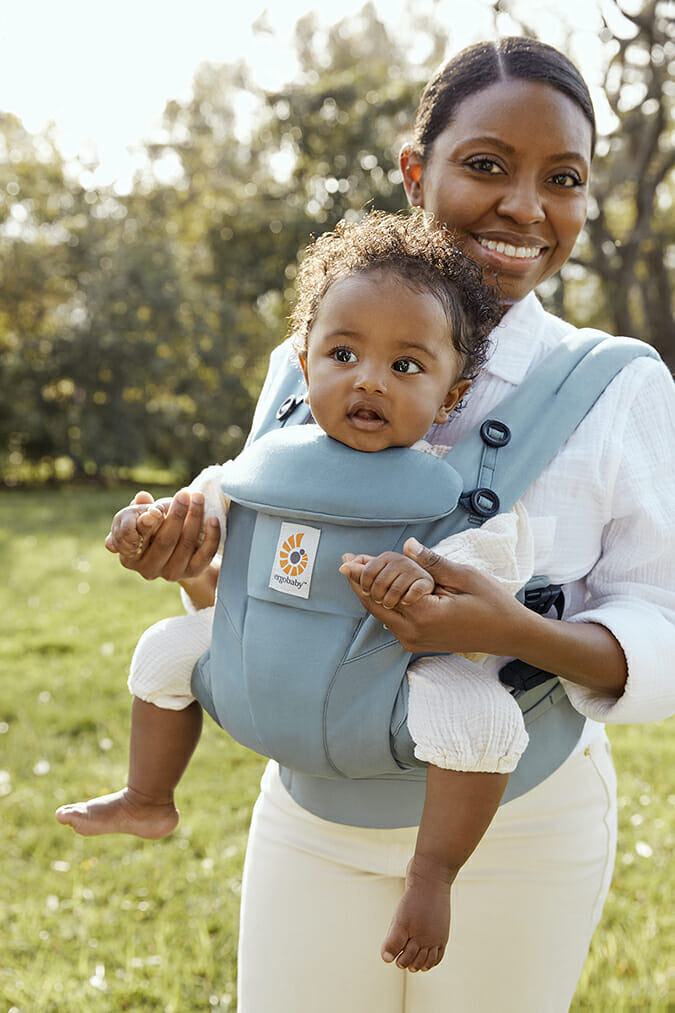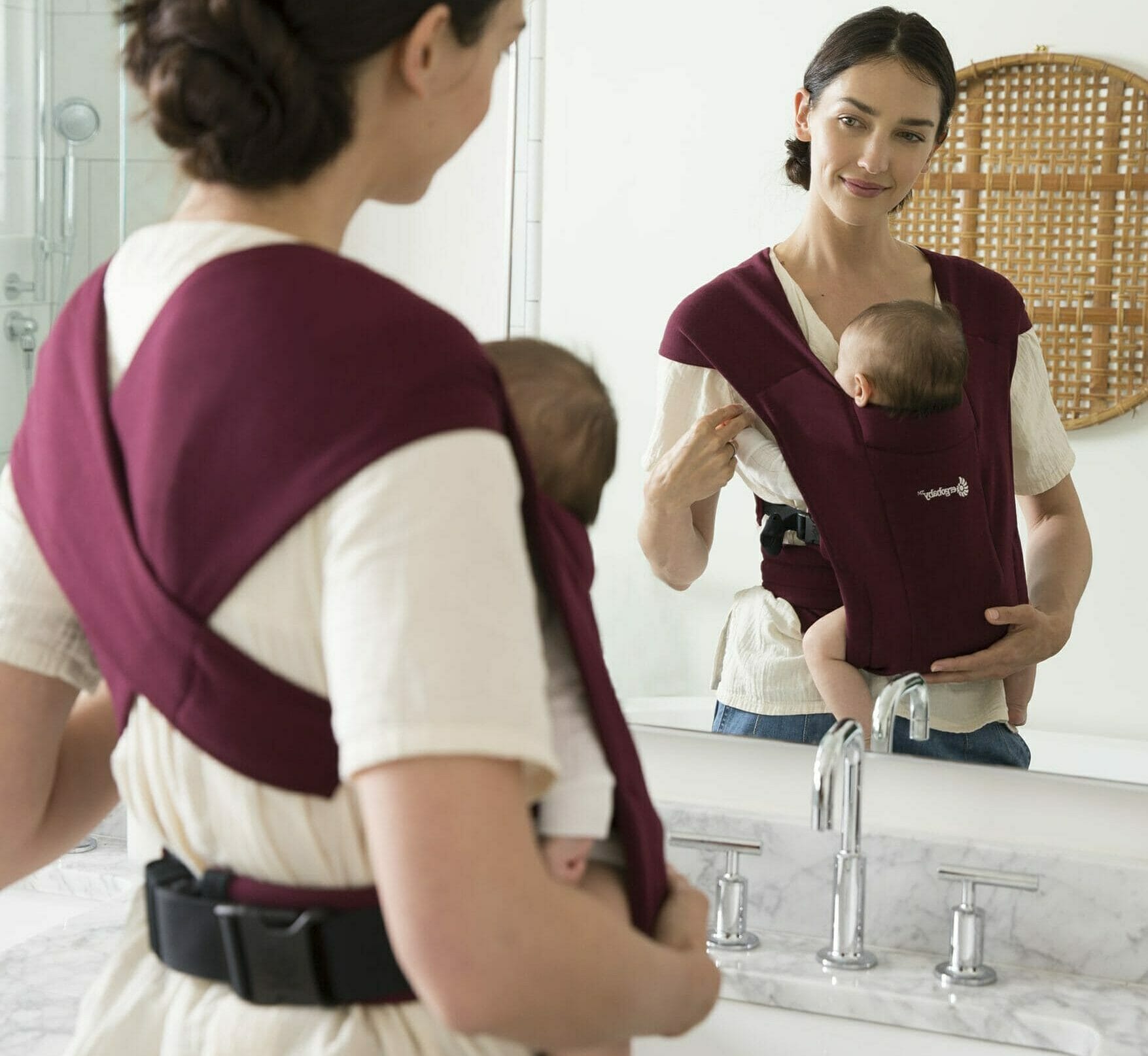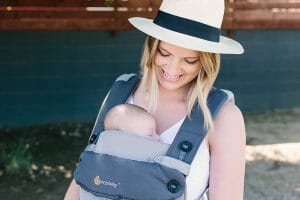
How to Check Baby’s Positioning in your Carrier
Our carriers are all designed to be easy to use and for baby to be perfectly supported no matter their age or size and in every carry position. But sometimes something doesn’t quite feel right or isn’t quite working. The good news is that this can very likely be fixed with some very simple adjustments to how you wear your carrier or position baby in it.
Set up is key
First step is to check your carrier is set up correctly. The easiest way to do that is to click this link and find your carrier on the page. Find whichever carry you’re looking for and watch the instructional video, it will include how to set your carrier up for that particular position. A few things to make sure of:
- If using one of our Original, Adapt, All Position 360 or Omni carriers, ensure you are using the correct velcro tabs on the inside of the waistband for your baby’s size. For those with our Aerloom or Embrace carriers you may need to roll the carrier if you have a newborn, follow the instructions on your carrier or via the link above to see if you need to do this.
- If your carrier has a neck support cushion make sure it is either buttoned to the inside if baby is under 6 weeks and cannot hold their own head or to the outside for babies that can hold their own head. It should only be buttoned up to the top buttons for extra support when baby is sleeping/for an older baby
- For our All Position 360, Omni and Aerloom carriers, make sure the buttons/sliders/tabs are on the right setting for either inwards or outwards facing (whichever setting makes the carrier panel narrower is for outwards facing and wider is for inwards facing positions)
- If you are using our Original or All Position 360 carriers for a baby under the age of 4 months make sure you have our infant insert correctly inserted (use the link above for instructions on this). No other carrier needs this insert.
- Make sure the shoulder straps are buckled and loosened (with the buckles through the webbing loops where your carrier has them) – unless your carrier supports criss-cross shoulder straps and you are choosing this option
Always Follow the T.I.C.K.S. Rules for Safe Babywearing
Then, no matter what carrier you’re using or which position you’re using it’s a great habit to get into to always do a TICKS check. Not only does this keep baby safe in their carrier it will cover most positioning issues you may find you’re having as the chances are, if baby is in a TICKS safe position the rest is just fine tuning.
Tight
Your wrap or carrier should be tight enough to hug your baby close to you, as this will be most comfortable for you both. Any slack/loose fabric will allow your baby to slump down in the carrier which can hinder their breathing and pull on your back. It’s almost impossible to over-tighten your carrier, you will find it uncomfortable before baby does as your diaphragm moves more than theirs does when you breathe. A good check to tell if your carrier is tight enough is to gently lean forward, if baby’s body comes away from yours or slumps/flops in any way then your carrier is too loose – baby shouldn’t come away from your body.
If baby is already in the carrier and you’re struggling to tighten the straps, support baby’s weight with your spare hand to take the pressure off the buckle (they’re designed not to move once baby is in the carrier to keep them safe and secure!), and make sure you’re pulling backwards along the line of the rest of the strap. Hannah Wallace at Wear My Baby has a great demo of this.
In view
You should always be able to see your baby’s face by simply glancing down. The fabric of a sling or carrier should not close around them so you have to open it to check on them. In a cradle position your baby should face upwards not be turned in towards your body. Top tip, if you’re using our Embrace carrier or Aura Wrap, make sure the fabric is pulled down over your shoulders – you can even turn the fabric inside out on an Aura Wrap to stop them sliding up. If you’re using a more structured carrier you can bring baby’s arms and hands up as if they were giving you a high ten to give them more stability and stop their face ending up behind the carrier strap.
Close enough to kiss
Our waistband is designed to go… you’ve got it… around your waist – not your hips! This should allow baby to be close enough that you can kiss the top of their head by just gently tipping your head forward. As well as being safest for baby it will also help your back as it allows the waistbelt to support most of baby’s weight, keeping it from pulling down on your shoulders.
When using a carry with lumbar support (Adapt, All Position 360, Aerloom or Omni carriers) make sure to tighten from both sides of the lumbar support so it sits evenly in the middle of your back (or front when wearing baby on your back) and make sure it sits flat and level against your body e.g. it isn’t dipped down lower than the front than the back. This will help baby sit deep in the bucket seat and achieve the all important M shape position.
Keep Chin off Chest
If you baby is positioned correctly they should be able to easily keep their chin off their chest. Particularly important for newborns but also can be a concern when any age baby is sleeping and is the main reason baby sleeping outwards facing is NEVER safe. A carrier worn high and tight on your body will help prevent babies from slumping. Ensure there is always a space of at least a finger width under your baby’s chin.
Supported back
Babies back should be well supported in the carrier, with their tummy and chest gently touching you and their back making a gently rounded C shape. If you’ve followed the steps above to ensure baby is firmly secured and your shoulder straps feel too tight or are digging in under your armpits then check your back strap, it should be just above where your bra sits (if you wear one!) and be nice and tight.

Final checks
You’re nearly ready to go! A few last checks will help ensure babies hips and legs are in the right position. No matter which carrier you are using or in which carry position baby’s legs should be supported knee to knee (especially when they are younger, with toddlers this may not always be completely possible) by the fabric panel. Make sure you have the correct setting for their size (see instruction video link above) and just give the body panel fabric a pull to make sure it’s as wide as it will stretch.
Then last but certainly not least what may be our favourite positioning check? The Pelvic Tuck. So important it gets it’s own blog post!
And remember if you’re ever concerned about baby’s positioning or just can’t quite get something right then you can email us at [email protected] or contact us via Facebook or Instagram, we’re always happy to help check positioning and offer handy tips and tricks! Happy babywearing everyone!





